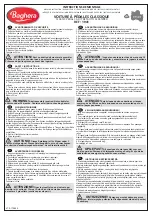
11
en
settIng the Brake lInkage
The Revenge Type N buggy comes with the brake linkage adjusted to
provide strong balanced braking power. As you complete the engine
break-in process, the brake discs also conform to the brake pads.
At this time you may start adjusting the brakes to your liking.
The ECX Revenge Type N buggy gives you the ability to not only
adjust overall brake power, but also allows you to adjust brake bias.
Brake bias is the ability to adjust the power of the front and rear
brakes independently of each other. Brake bias can be used to help
control not only how well the car stops, but also how the car reacts
in turns, adding to your tuning options.
checking Brake Bias
To check the front brake bias:
1. Lift the rear of the car and apply full brakes.
2. Roll the car forward and backward across a surface that
is similar to the surface on which you intend to drive. Note
the braking force applied.
To check the rear brake bias, lift the front of the car and repeat
Step 2 above.
Brake Bias adjustment
IMPortant:
Make very small adjustments (about 1mm to
the brake bias). Do not try and attempt to get an acceptable brake
bias setting by only adjusting one of the two collars. Make small
adjustments one at a time to the A and B collars alternately until
you achieve the desired setting.
• Moving collar "A" toward the spring provides more rear braking
power in relation to the front
• Moving collar "A" away from the spring provides less rear braking
power in relation to the front
• Moving collar "B" toward the spring provides more front braking
power in relation to the rear
• Moving collar "B" away from the spring provides less front braking
power in relation to the rear
Brake force adjustment
When you achieve the desired balance of front to rear braking force
(bias), use the adjusting knob to achieve stronger or weaker overall
braking force. Turning the adjusting knob does not affect the brake
bias. Make small adjustments at a time (about 1/2 turn).
• Turn the adjustment knob clockwise to weaken or soften
the overall braking power.
• Turn the adjustment knob counter-clockwise to strengthen
the overall braking power.
IMPortant:
The brakes should not be applied at the
neutral throttle point. The vehicle should roll freely when
the throttle trigger is at the neutral/idle throttle position
tips for adjusting the Brakes
• Adding more front brake bias in comparison to the rear allows
greater stopping power in a straight line.
• If the front brake bias is too strong in comparison to the rear, the
vehicle will lose steering control or "push" due to the front wheels
locking up under braking.
• Adding more rear brake bias in comparison to the front is a great
turning tool, especially for more experienced drivers. Adding more
rear brake bias in comparison to the front will allow the vehicle
to turn into corners much better or "rotate".
• If the rear brake bias is too strong in comparison to the front,
the vehicle will spin out under hard braking.
• Surfaces dictate brake settings. On surfaces with less traction,
less overall braking power is required. On high traction surfaces,
more braking power can be utilized.
• Under no circumstances should the brakes "lock up" or skid.
Maximum braking power is achieved just before any of the
wheels "lock up".
A springs
B springs
adjusting knob












































